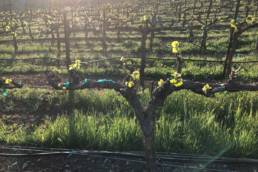FMN – December 2021 – Chehalem Mountains AVA
This is the time of year when every wine periodical and self-acknowledged wine “expert” feels obliged to provide a retrospective view of the last eleven months’ worth of wine pontifications. These lists profess to be the best of the year but very rarely do they even come close to meeting that mark. Mostly, they represent either a favor to a producer, a confabulation to make the expert appear that they have a secret list of all best wines available to man, or (more likely) a conglomeration of previous articles patch-quilted together by an unmotivated or otherwise lazy wine writer to fulfill their wordcount.
Although I may have been guilty of all those accusations at one time or another, this month I maintain my innocence and will refrain from such foolishness. Instead, I will hopefully entice you into trying an area that, to my humble opinion, is painfully understated and delightfully unapologetic about their successes, setbacks and diverse individuality.
The Chehalem (Sha-HAY-lum) American Viticultural Area (AVA) is a contiguous uplifted landmass in northern Willamette Valley (Oregon), extending 20 miles in length and 5 miles in breadth. The mountains that share the same name are the highest in the Willamette with Bald Peak (at 1,633 feet) claiming the uppermost point. Being only 45 miles east of the Pacific Ocean offers some varying amounts of influence depending on the location of the vineyard and the heights of the surrounding geological structures.
Chehalem Mountains’ winegrowing dates back to 1968 when Dick Erath, coined as a “UC Davis refugee” purchased 49 acres on Dopp Road in Yamhill County. Although the uniqueness of naming the property Chehalem Mountain Vineyards could be questioned, his resilience and success cannot. By the 1970s, pioneers like the Adelsheims (first Chehalem winery in 1971), Ponzis and Paul Hart of Rex Hill Vineyard all saw the potential and joined in planting vineyards.
The AVA was finally established in 2006 and is contained entirely within the well-known Willamette Valley AVA. What once was the “frontier” of viticulture now contains one hundred seventy-nine vineyards, fifty-three wineries and over thirty tasting rooms. Despite the increasing growth over the last few decades and proximity to Portland, Chehalem maintains an intimate, small farming community vibe. With the average land holding less than 15 acres and only about 2700 acres under vine of the 62,000 in the entire AVA, there remains tremendous opportunity for growth.
One might rightfully question the significance of this carved out section of Willamette Valley and inquire what makes it any different from the rest of this huge wine growing area. As hinted to previously, one of the strengths of this AVA remains with its multifaceted diversity.
The temperature variations are the widest in Willamette Valley and are affected by the degree of elevation, with grapes ripening up to three weeks earlier on the higher sites than lower down the mountain. A blend of grapes from these differing elevations can ensure optimal phenolic ripeness while maintaining freshness with bright acidity.
The differing slopes, aspects and exposure to Pacific Ocean breezes also have a dramatic impact on grape growing. These elements not only affect sun angle (and thus ripening) but also precipitation levels. One demonstration of this shows the northwest edge of Bald Peak bearing the brunt of this Pacific Ocean influenced precipitation, while the southeast part remains much warmer and drier.
Soil types represent another element of diversity of growing conditions. The entire area was once an uplifted ancient sea bed so marine sediments are found throughout but distributed primarily along the northwestern flank of the region. Red soils from prehistoric volcanic activity are concentrated in the southeastern Chehalem Mountains. Wind-blown glacial silt (loess) can be found on north facing hillsides and primarily in the northeast flank of this area. Large swaths of Willakenzie and Laurelwood soils further define the Chehalem Mountains with two contained AVAs, Ribbon Ridge and Laurelwood District, established in 2005 and 2020, respectively. These varied soil types cannot be understated, in my opinion, as the milieu of wine roots offer the greatest expression of terroir and are demonstrative in the final wine.
This diversity of growing conditions creates a multitude of mesoclimates and lends to the wide variety of grapes grown here. Although the most common grape varieties: Pinot Noir (69.89%), Pinot Gris (3.79%), Chardonnay (3.75%) have made a grand statement of success, they share vineyard area with upstarts such as Pinot Blanc, Riesling, Grüner Veltliner, Gamay Noir, Gewürztraminer, Syrah and even Marechal Foch. The number and diversity of grape varieties continue to expand as forward-thinking growers push experimental plantings and winemaking to their limits.
The final piece of the puzzle for success in the region comes with the winemakers and grape growers. The amazing diversity of these artists comes not only with their ethnic heritage but also with their differing philosophies of how great wine should be made. This being the reason that when you open a Chehalem Mountain Pinot Noir, for example, that was grown under the almost same growing conditions, the resultant wines can be so different. That truth, to me, exemplifies the magic of winemaking.
As you round out the final month of this year and prepare for anew, look not to the ramblings of the self-indulgent wine writers. Start creating your own list of wines that hit the sweet spots on your palate and stay within your Holiday tattered budget. I hope some of these suggestions find their way to your celebratory tables and I sincerely wish you and yours a very Merry Christmas and Happy New Year.
Suggested Wines / Wineries:
** These are only a cross section of the selections available. I invite you to go to the websites for more wine and winery information. All wines provided as samples for consideration by respective wineries. **
Dion Vineyards
Al Johnson had grown grapes in the Yakima Valley for years and was more than eager to help when his son Ron and Joanne (Ron’s wife) make their 5-acre purchase in Willamette Valley back in 1973. Today this dream has grown to 60 acres. Ron and Joanne have since passed the torch to their son Kevin (and Kevin’s wife, Beth Klinger) who started producing wine under the Dion Vineyard label in 2007.
What would be called boutique levels of production of Pinot Noir, Pinot Gris, and Sparkling Wines, the couple intentionally maintain a small production as part of their commitment to high quality grapes (and wine) at an exceptional value. Kevin and his wife handcraft under 1000 cases per year, including miniscule amounts of Tempranillo, Viognier, Chardonnay and even some rosé.
Being stewards of the land and taking that title very seriously, Dion Vineyards are L.I.V.E. (Low Input Viticulture and Enology) Certified, verifying their use of sustainable agricultural techniques. Their practices are highly thought of and some of these 60 acres are used to provide sourced grapes for other Willamette Valley wineries.
Kevin traveled an interesting road to becoming a winemaker. After graduating from the Naval Academy, Kevin spent a decade as a Naval Officer. He “picked up” a degree in aerospace engineering, as he modestly puts it, and even worked at SpaceX in Los Angeles. He jokingly compares the similarities between rocket science and wine making as “hard work, crazy hours, and crazy people”.
2017 Wedding Tree Cuvee Brut Laurelwood District AVA $55
Composed from 94% Pinot Noir, 6% Chardonnay this traditional method sparkling bursts with overt aromas of red fruit (strawberry, cherry), orchard fruit (apple) and a fresh baked brioche note. I akin this to a warm cherry / strawberry tart fresh out of the oven. The palate is dry with medium fine mousse and a mouth-watering persistent crunchy acidity. On the palate, the red fruit takes center stage and lingers on the finish with continued acidity. Pair with creamy cheeses, cured meat or brie and cranberry en croute. (Disgorged September 2020)
2016 Old Vines Pinot Noir Chehalem Mountains AVA $65
These Pommard clone Pinot grapes hail from a 41-year-old dry-farmed vineyard. The resultant wine has the classic earthy nuances (forest floor, wet autumn leaves) wrapped with a back drop of red fruit (cherry, cranberry) and slight all spice / cinnamon bark. The palate is dry with tart crunchy acidity, medium minus body and gently warming alcohol. The tannin structure is ripe and fine grained and a pleasant, lingering acidic red fruit finish. Pair with thyme chicken dishes, mushroom tarte with caramelized shallot, and serrano / Iberico ham.
Rain Dance Vineyards
Ken and Celia Austin have an interesting story as they began Rain Dance Ranch in 1991 and it quickly grew into one of the country’s premier llama ranches. They have had several national champions over their tenure and take great pride in their practice of breeding quality bloodlines.
As the small farming community began to rapidly grow, they saw the necessity to help preserve the area. Ken and Celia began acquiring parcels of land in order to preserve it for agricultural use. Over the next decade or so they became quite aware of the Willamette Valley becoming a world class wine destination. Realizing the many benefits of viticultural practices and determining it was one of the best ways for land preservation, they had one of their parcels evaluated to become a vineyard site. The property had the perfect terroir and in Fall 2009 their first vineyard was planted on Chehalem Mountain and Rain Dance Vineyard came to life.
The conservation-minded approach continues as noted by their vineyard manager, Evan Bellingar. He tells tale of the process of developing a new block. They walk the land and discuss each tree and how it could fit into the vineyard or leaving a grove so that deer can have a place to graze. The areas left “natural” are often potentially prime Pinot land but Ken and Celia feel the value of protecting the integrity of the land outweighs more profit.
Estate Gamay Grand Oak Vineyard 2020 Chehalem Mountains AVA $36
The vineyard has a preponderance of jory and laurelwood soil and its name is a testament to the ongoing preservation efforts to replant native oaks. The wine has aromas of red fruit: raspberry, cranberry (candied fruit), baking spice (all spice, anise). The palate is dry with crunchy red fruit acidity, medium body, low perceptive fine-grained tannins. The red fruit and baking spices carry through on the palate. The finish is medium with a raspberry, raspberry leaf and a slight minerality. This is a slightly different domestic version for the Beaujolais lovers. Pair with grilled chicken, brined pork chops, or charcuterie.
Anam Cara Cellars
Nick Nicholas, originally from Lodi and his Scottish wife Sheila met in London while they were both working in their respective pre-winery careers. In 1981, they returned to the states and were married in Cambridge, Massachusetts. After a stint in the pizza restaurant business, the family relocated to Oregon in 2001 purchasing a rundown walnut, plum and filbert orchard. This run-down orchard eventually became their vineyard and there are still some old fruit trees producing apples, pears and cherries.
The original 27 acres are located on a southeast-facing slope of the Willamette Valley’s Chehalem Mountains AVA in the hills above Newberg. They were planted with different Pinot Noir clones on varying rootstock as well as an additional acre each of Riesling and Gewurztraminer. In 2008, the family planted a further six acres, introducing more Riesling and Pinot along with adding some Chardonnay, as well as 1.5 acres of Wadenswil Pinot Noir.
In 2014, the Nicholas’ downsized their ownership to six acres, but still purchase some fruit from their original vineyards to make their wine. The words Anam Cara are Celtic for “friend of my soul” or “soulmate” and represent their connection with the land, the vines and the friends who share their wines.
Anam Cara Pinot Noir 2018 Chehalem Mountains AVA $42
An earthy Bourgogne-esque kind of nose with light cherry fruit at the core and earth (mushroom and rich soil). The fruit is slightly riper and more candied versus Burgundy but one can see crossover. The palate is dry, with bright acid, and medium body. The ripe cherry, strawberry element carries through to the finish after the earthy nuances fade. An elegant, easy drinking Pinot that will pair with dishes containing black eyed peas, mushrooms or just to celebrate life.
J K Carriere Wines
In 1999 after gaining experience working for eight classic Pinot Noir producers (OR, NZ, AUS, FR) and while still working for two, Jim “boot-strapped” his passion, created a contraction of his two grandfathers’ names (J.K. Prosser and Paul Carriere), and started making wine as J.K. Carriere Wines in Newberg, Oregon. The first decade of operations were humble, at best, operating out of a true 100-year-old barn and armed with the belief he could harness the soul of Burgundy in Oregon dirt.
Jim purchased 40 acres of land on the southeast portion of Parrett Mountain in 2007 and two years later the first blocks of Chehalem Mountains AVA vineyards were planted and a new winery building was completed. Although he still sources fruit from carefully selected growers, this was his piece of dirt, a truth and responsibility he takes very seriously.
He also has strong opinions in how wine should be made and a passionate belief in the magic of native yeast. He explains that as yeast populations rise and fall and do their work and perish, only to be taken over by a different strain, flavor and aromatic nuances are left behind leaving layers of complexity that couldn’t be provided by a single contrived strain. To search for the proof of this one only has to sample his wines. After a roller coaster ride of a life, he is self-aware, thought-provokingly passionate, and contagiously unapologetic about his wines. He sums all this up in his statement, “We are, in fact, what we want to be.”
J K Carriere St. Dolores Estate Pinot Noir 2019 Chehalem Mountains AVA $72
The wine, as indicated by the producer, needs some decanting to open up as these wines are young. Initially the aromas of toasted oak jump out but fade to subtle red fruit, layers of sweet and savory baking spices, and slight carraway seed. The palate is dry with mouth-watering acidity (ageability), medium body, and noticeable ripe and small grained tannins (again will integrate more with bottle age). The finish showcases the earthy elements one would expect. The strength of this wine is its subtly, texture and elegance. Decant and drink now or give it 5 to 10 more years in bottle to allow full evolution. If drinking now, as I am, pair with wild mushroom risotto and grated parmesan, game birds or conversation with the best of friends.
J K Carriere Gemini Vineyards Pinot Noir 2019 Chehalem Mountains AVA $72
The wine took a bit to open up but the level of complexity was well worth the wait. Aromas of candied cherry, blueberry, sweet baking spice, peppercorn, cocoa powder and raked leaf pile after a rain. The dry palate has a vibrant acidity with evident fine grained developing tannins; a testament to welcoming more bottle age. The length is medium and the finish clean with an acid wash cleansing. When it comes to Pinot, this is definitely a burlesque show rather than a striptease. Pair with the same: wild mushroom risotto and grated parmesan, game birds or conversation with the best of friends.




